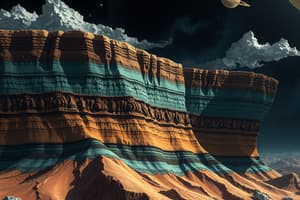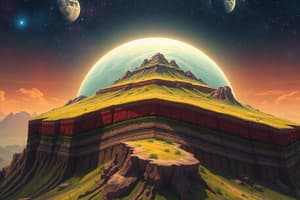Podcast
Questions and Answers
Which of the following best describes the Earth's crust?
Which of the following best describes the Earth's crust?
- A layer composed of puzzle-like pieces that float and move. (correct)
- A solid, unified layer with a consistent thickness.
- A liquid layer that flows due to temperature differences.
- The thickest and densest layer of the Earth, rich in iron and magnesium.
What is the primary composition of the Earth's mantle?
What is the primary composition of the Earth's mantle?
- A mix of liquid iron and nickel with trace amounts of silicon.
- Gases and light elements such as hydrogen and helium.
- Silicate rocks rich in iron and magnesium. (correct)
- Primarily iron and nickel in a liquid state.
What is the main process that contributes to the movement of the Earth's crust?
What is the main process that contributes to the movement of the Earth's crust?
- The expansion and contraction of the inner core.
- The slow movement of material within the mantle. (correct)
- Electromagnetic forces generated in the outer core.
- The gravitational pull from the Sun and Moon.
Which Earth layer is primarily responsible for generating Earth's magnetic field?
Which Earth layer is primarily responsible for generating Earth's magnetic field?
What distinguishes the inner core from the outer core?
What distinguishes the inner core from the outer core?
How does the Earth's magnetic field benefit life on Earth?
How does the Earth's magnetic field benefit life on Earth?
What is the approximate thickness of the Earth's mantle?
What is the approximate thickness of the Earth's mantle?
Which of the following is NOT a characteristic of the Earth's inner core?
Which of the following is NOT a characteristic of the Earth's inner core?
Flashcards
Layers of Earth
Layers of Earth
Earth consists of four main layers: crust, mantle, outer core, inner core.
Crust
Crust
The outermost layer of Earth where we live, about 5-30 miles thick.
Continental Crust
Continental Crust
Thinner part of the crust that forms land areas on Earth.
Oceanic Crust
Oceanic Crust
Signup and view all the flashcards
Mantle
Mantle
Signup and view all the flashcards
Outer Core
Outer Core
Signup and view all the flashcards
Inner Core
Inner Core
Signup and view all the flashcards
Earth's Magnetic Field
Earth's Magnetic Field
Signup and view all the flashcards
Study Notes
Earth's Layers
- Earth has four main layers: crust, mantle, outer core, and inner core
- Each layer has distinct characteristics and plays a critical role in Earth's functions
Crust
- Outermost layer, where we live
- Comparatively thin, 8-50 km thick
- Two types: continental (land) and oceanic (oceans)
- Composed of puzzle-like pieces that move on the mantle
Mantle
- Thickest layer (84% of Earth's volume)
- Beneath the crust, extends to 2,900 km
- Made of silicate rocks, rich in iron and magnesium
- Acts like a solid but flows slowly like a liquid, driven by heated material rising and cooler material sinking
- This movement drives tectonic plate motion.
Outer Core
- 2,250 km thick
- Liquid layer
- Composed mainly of iron and nickel
- Temperatures range from 4,000-5,000°C
- Movement of liquid iron/nickel creates Earth's magnetic field
- Protects Earth from harmful radiation
Inner Core
- Deepest layer, located 5,150 km below the surface
- Solid due to extreme pressure
- Extremely hot, reaching 5,500°C
- Primarily composed of iron and nickel
- Plays a critical role in generating Earth's magnetic field, shielding Earth from solar radiation.
Studying That Suits You
Use AI to generate personalized quizzes and flashcards to suit your learning preferences.




